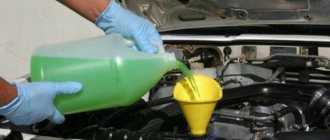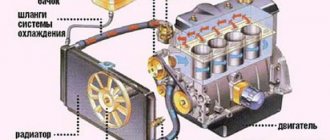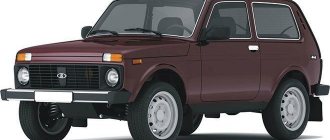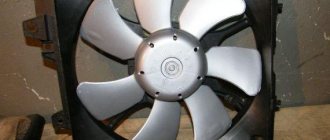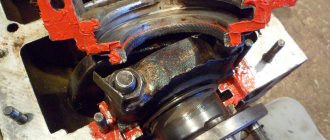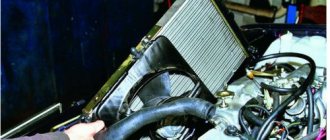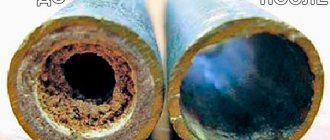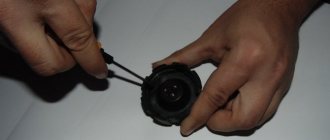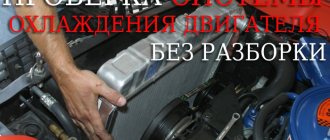Published: 01/28/2021
- What is not recommended for flushing the cooling system?
- 1 Why flush the cooling system?
- The effect of flushing the cooling system with Coca-Cola
- What not to do when cleaning your engine cooling system
- Flushing the engine cooling system using traditional methods
- Storing instant coffee
- When is flushing needed?
- Why and when do you need to flush your car's cooling system?
- How to flush the cooling system with acidified water, advantages and disadvantages
- Flushing agents
- Traditional means for washing
- What should you not use?
What is not recommended for flushing the cooling system?
Among the so-called folk remedies, there are a number of those that are not recommended for use, despite the fact that some car owners still use them, and in some cases they even help. Let's give a few examples.
Coca-Cola
Using Coca-Cola as a Cleaner
Some motorists use Coca-Cola to flush the cooling system of oil, emulsion, scale and rust. The fact is that it contains orthophosphoric acid, with which you can easily get rid of the mentioned contaminants. However, in addition to acid, this liquid contains large amounts of sugar and carbon dioxide, which can lead to certain problems.
If you decide to use Cola as a cleaning liquid, it is better to first release carbon dioxide from it so that during the expansion process it does not harm individual engine components. As for sugar, after using the liquid, you must thoroughly rinse the cooling system with plain water.
Also remember that phosphoric acid can harm plastic, rubber and aluminum parts of the cooling system. Therefore, “Cola” can be kept in the system for no longer than 10 minutes!
Fairy
Some car enthusiasts use the popular household grease cleaner Fairy or its analogues to flush the cooling system of oil. However, its use is associated with a number of problems. Firstly, its composition is designed to combat dietary fat, and it simply cannot cope with motor oil. And even if you try to pour it into the radiator, you will have to fill and “boil” the engine several dozen times.
Therefore, we DO NOT recommend that you use household grease removers like Fairy and similar products.
Calgon and its analogues
Calgon, Tiret and similar products are not recommended for cleaning radiators, since their intended purpose is to remove limescale deposits on water pipes.
"White"
The peculiarity of “Belizna” is that it contains sodium hypochlorite, which corrodes aluminum. And the higher the temperature of the liquid and the working surface, the faster corrosion occurs (according to the exponential law). Therefore, under no circumstances should you pour various stain removers into the system, especially those containing bleach and compounds based on it (including “Mr. Muscle”).
"Mole"
Known in narrow circles, “Mole” is made on the basis of caustic soda. Accordingly, they cannot be used to treat aluminum radiators and other surfaces. It is only suitable for cleaning copper radiators (in particular, stove radiators) and only by removing it and running such a cleaner through the system will you kill all the rubber seals and seals.
Other mixtures
Some car enthusiasts use a mixture of citric acid (25%), soda (50%) and vinegar (25%) for cleaning. However, we do not recommend that you do the same, since it is very rough and corrodes rubber and plastic parts.
These cleaning agents are only permissible if you need to flush the stove radiator and you do not plan to circulate liquid throughout the cooling system.
What kind of oil to fill in the VAZ engine of LADA cars
The first thing a new car owner has to deal with is finding out what technical fluids are in the car and how soon they should be replaced. The engine is considered the main unit, so most often they start with motor oil.
Let us remind you that AvtoVAZ installs the same type of power units on its models, so the recommendations on “what oil to fill in the engine” will be the same for all modern Lada cars (Granta, Priora, Kalina, Largus, Niva, Vesta or XRAY).
AvtoVAZ installs the following engines on Lada cars:
| Engine model | Volume, l | Power, hp | Number of valves, pcs | Engine oil volume, l | Installed on cars |
| VAZ-21114 or VAZ-11183 | 1,6 | 81 | 8 | 3,5 | Granta and Kalina |
| VAZ-21116/11186/11189 | 1,6 | 87 | 8 | 3,5 | Granta, Kalina 2 and Priora, Largus |
| VAZ-21126 | 1,6 | 98 | 16 | Priora, Kalina, Granta and Kalina 2 | |
| VAZ-21127 | 1,6 | 106 | 16 | 3,5 | Priora, Kalina 2, Granta |
| VAZ-21126-77 | 1,6 | 118 | 16 | 3,5 | Granta Sport |
| VAZ-21128 | 1,8 | 98 | 16 | 3,5 | Priora |
| VAZ 11194 | 1,4 | 89 | 16 | 3,5 | Kalina |
| VAZ 21129 | 1,6 | 106 | 16 | Vesta, Lada XRAY | |
| VAZ 21179 | 1,8 | 122 | 16 | ||
| VAZ 21214 | 1,7 | 81 | 8 | 3,75 | Niva 4x4 |
* — When refueling a dry engine for the first time (when changing the oil and oil filter)(1) — stamped oil sump (AMT)(2) — cast oil sump (manual transmission)
We select Niva 4x4 engine oil in a separate article.
What motor oils are recommended by AvtoVAZ? If you open the Operating Manual for the car and its modifications, not the latest edition, you can find table No. 2 “Motor oils”. Comparing them for different Lada cars, you can understand that AvtoVAZ recommends the same motor oils for Lada Granta/Kalina/Priora engines.
For Lada Vesta, AvtoVAZ recommends using Rosneft brand motor oil, API class SL, SM or SN.
What brand of oil does the Lada come from the factory?
- Engine 1.6: Rosneft ROSNEFT MAGNUM MAXTEC 5W-30 STO 44918199-091-2017 semi-synthetics.
- Engine 1.8: until 05.2018 LUKOIL GENESIS SAE 5W-40 STO 79345251-040-2010 synthetics, from 05.2018 ROSNEFT MAGNUM MAXTEC 5W-40 STO 44918199-091-2017 semi-synthetics.
You can add ROSNEFT Premium or ROSNEFT Maximum 5W-40 or 10W-40. Or Lukoil Genesis RN 5W-40.
You can determine the viscosity of engine oil using the following table:
| Minimum engine cold start temperature, C | Viscosity grade according to SAE J 300 | Maximum ambient temperature |
| Below -35 | 0W-30 | 25 |
| Below -35 | 0W-40 | 30 |
| -30 | 5W-30 | 25 |
| -30 | 5W-40 | 35 |
| -25 | 10W-30 | 25 |
| -25 | 10W-40 | 35 |
| -20 | 15W-40 | 45 |
| -15 | 20W-40 | 45 |
How to determine the composition of motor oil? To answer this question, we conducted surveys among owners of Lada Grant, Lada Kalina and Lada Priora, asking them to answer the question “What oil composition do you use in your car?” as a result, we received approximately the same results:
What brand of oil do you use? The next polls and very similar results:
The survey below will help you finally decide on the choice of engine oil. Take part in our survey and discussions. Let us remind you that the website contains instructions for changing engine oil, as well as recommendations on which engine oil is best to choose based on viscosity and composition. By the way, the Lada Vesta is also equipped with an HR16 engine; read recommendations on choosing lubricants for it here. For Lada Largus with Renault K4M or K7M engine here.
Source
The effect of flushing the cooling system with Coca-Cola
Another completely unusual solution is to rinse the SOD with Coca-Cola, but for some reason it seems strange to many that the drink can corrode dirt. But there is still an explanation for this chemical reaction: the “soda” contains orthophosphoric acid (acidity regulator). According to some drivers, Coca-Cola actually helps to wash the inner walls of the radiator and is not the worst flushing agent. But before using this composition, you must open the bottles of liquid and wait until the gas is completely released from them.
For rinsing, the Coca-Cola drink is not diluted with water, it is filled entirely, which means that to refill a 10-liter PO you need to buy five large bottles of lemonade. But is it worth experimenting with such an unusual product for a car, when there are a lot of proven compounds, as well as certified products specifically designed for these purposes?
What not to do when cleaning your engine cooling system
The black list was headed by drugs of household origin. The disadvantage of using them is that they are too aggressive on aluminum radiators, causing them to corrode in a matter of minutes. This is first of all:
- Mole and its alternative. The composition contains caustic soda, which instantly corrodes the thin walls of the aluminum radiator.
- White. Contains sodium hypochloride, a component that corrodes aluminum products.
As for Calgon and Fairy, everything is in order with chemical neutrality. Their effectiveness is questionable. So, Calgon copes only with scale, passing by rust, and Fairy is practically powerless against any inclusions contained in the cooling system. In addition, Fairy foams quite a bit, making it quite difficult to rinse the insides after using it.
Flushing the engine cooling system using traditional methods
There are exotic and less civilized methods of washing, invented by folk craftsmen when special auto chemicals were not so accessible.
Milk serum
Instead of contaminated antifreeze, serum is poured into the system, slightly above the minimum level in the expansion tank (up to 10 liters can be consumed). There is no consensus on how long to keep the serum in the engine. Someone drives with serum filled with serum for 200-300 kilometers, then it is drained. Some people advise filling it, warming up the engine and leaving it idling for a period of 5 minutes to one hour.
If the drained liquid is very dirty and contains oil clots, then the procedure for washing with serum can be repeated using one of the above methods. After flushing, you need to flush the system with running water, fill it with clean water, warm up the engine again and let it run for about 5 minutes. If the drained liquid is clean, then you can fill in new antifreeze.
Carbonated drinks
Cola, Sprite and Fanta contain phosphoric acid, which can dissolve almost anything. Mixing is carried out in the following proportion - half the volume of water or antifreeze and the remainder - a drink. The engine is warmed up and allowed to run for five to six minutes. Then turn off the engine and leave it to settle for half an hour.
Lemon acid
For cleaning, citric acid must be dissolved in water at the rate of 1 kg of powder per 10 liters of liquid. With little contamination, the amount of acid can be reduced to 500 g.
With the solution poured in, at medium speed, the engine should run for 15-20 minutes, and then let it sit for about 45 minutes. After draining, it is also necessary to rinse the system thoroughly with running water.
Dishwashing detergents
Various household dishwashing detergents are very good at removing grease and oil from any surface. They are also used to flush the cooling system. Half a bottle of any product is added to the system; if it is heavily soiled, you can also fill a full half-liter bottle.
The liquid must be dissolved in water and poured into the cooling system. Warm up the machine and leave it running for 15 minutes. If the drained liquid contains a large amount of oil, you can repeat the procedure several times. Alternatively, with such a filled solution, you can drive a car for a couple of days or about 100 km.
When clean water (without visible oil impurities) begins to drain from the system, you need to rinse the system with running water and you can fill in fresh antifreeze. Household detergents have increased foaming, so when warming up a car with a solution filled, it is necessary to check the expansion tank and the radiator filler neck.
Prevention for the stove
- After cleaning the radiator, replace all hoses and clamps of the heating system with new ones.
- From time to time, clean the air ducts from leaves and dirt, the ingress of which reduces the heating efficiency.
- Buy only good quality coolant to prevent re-contamination of the stove with impurities found in cheap antifreeze.
- Don’t be lazy to periodically blow out the outer fins of the radiator with the fan turned on at maximum.
By following the instructions above, you can easily cope with any method of flushing the heater. And if you also periodically carry out preventive maintenance for your car, you will postpone the flushing procedure for a long time.
When is flushing needed?
I give examples when washing is necessary:
- A sure sign that the cooling system needs to be flushed is the darkening of the coolant, it becomes black or orange from rust, this is noticeable in the fluid reservoir and if you remove the cap on the radiator.
- Problems arise with cooling the engine, even if all the blame is placed on the thermostat, flushing still won’t hurt.
- When preparing the car for the transition to the summer or winter season (that is, approximately every six months)
- When replacing one coolant with another, flushing is also necessary, just as when changing oil, the lubrication system is flushed of oil (old used oil).
- The heater in the car doesn't heat up. Yes, it also heats up from the cooling system, and if it doesn’t work, it means part of the system is clogged!
Expert advice
The operation of the VAZ-2110 cooling system depends not only on timely flushing, but also on other equally important characteristics. Specialists involved in the repair and restoration of cars of various classes and brands recommend following the following operating requirements:
- Don't skimp on the quality of antifreeze. Antifreeze, which is most often poured into the VAZ-2110, reduces the period of active operation of the car. If it breaks, repairs will cost much more.
- Make it a rule to carry out flushing as planned - once a year is enough, 2 times a year is ideal.
- Monitor the condition of the cooling solution and change it completely.
- If your gut feeling tells you that it’s time to wash the parts, don’t delay it. Taking good care of your car will eliminate many problems and prevent new ones.
Why and when do you need to flush your car's cooling system?
The internal combustion engine cooling system must be flushed if it is clogged. CO includes a number of components that must work correctly and interact with each other. This will allow antifreeze to cool the hottest elements of the power unit. The most vulnerable component of the cooling system is the pipes. Over time, they become clogged and destroyed as a result of exposure to high loads.
While using the machine, sand, crushed stone, stones from the road, as well as insects can get into the engine compartment, which leads to the formation of dirt on the unit. As a result, some of the contaminants appear in the CO and mix with the consumables. This contributes to the formation of scale on the metal components of the system, which eventually peel off and get into the pipes. As a result, the lines begin to become clogged, and this contributes to a decrease in the efficiency of the CO; in some cases, its complete failure is possible.
Proper flushing will effectively remove contaminants from the lines. You can know when cleaning is necessary when the antifreeze indicator appears on the control panel. If the light comes on, this may indicate not only the lack of consumables, but also the presence of problems in the operation of the CO. Experts recommend performing the washing process at least every two years.
Standard and major repair work: VAZ-2111 engine (8 valve injector)
Standard (typical) engine repair work on any vehicle is often needed not only when the car stops working. Depending on the indications, they may include the following operations:
- Replacement of components:
- valve lifters;
- oil deflector valve caps;
- timing belt;
- camshaft oil seal.
- Disassembly:
- cylinder heads;
- oil pump.
- Removal and subsequent replacement:
- lamp sensor that controls oil pressure;
- low oil level sensor;
- rear support of the power unit;
- manifolds – intake and exhaust;
- housings of auxiliary units;
- oil receiver;
- power unit supports;
- oil pan;
- camshaft;
- receiver and collectors.
- Adjustment:
- thermal clearances in the valve mechanism.
- Dismantling the ShPG (connecting rod and piston group).
Experts also include removing the engine from the vehicle as repair work. But this procedure is carried out already at the moment when the car needs major repairs. By major repair work related to the VAZ-2111 engine, experts mean the following operations:
- Complete disassembly.
- Diagnostics.
- Direct repair.
- Metalworking of those elements that need it (for example, grinding a crankshaft or milling a cylinder head).
- Replacement of parts that have failed.
- a detailed description of the designs of components and systems of the listed passenger car models;
- the main faults are characterized;
- causes of breakdowns and malfunctions in the functioning of the engine;
- DIY troubleshooting methods;
- Applications are posted with a list of necessary materials for current and major repair work (for example, lubricants, operating fluids), tools.
In addition to clear and intelligible technological instructions, it contains 15 electrical circuits, as well as photographs with comments.
How to flush the cooling system with acidified water, advantages and disadvantages
Flushing the cooling system with acidified water is one of the longest, but it is worth spending about 6 hours to get rid of scale for a long time and improve engine heat transfer. If traces of scale or dirty sediment were found in the drained antifreeze, then such a cooling system must be flushed with a special solution. Often, car enthusiasts use an acidified solution to more effectively cope with contaminants in the system.
The washing procedure is not too complicated, it takes longer than when using other cleaning products. First, you should prepare a slightly acidic solution using distilled water and acid, and then pour it into the cooling system. When all the fluid is in the system, tighten the filler neck, start the engine and leave it running for about 15 minutes.
When the engine is turned off, you should leave the oxidized liquid inside the system for about 3 hours so that all the scale has time to come off from the walls of the pipes. After 3 hours, you can drain all the liquid and repeat the entire procedure again. Finally, rinse the system again with distilled water.
This method has one big drawback - if you add too much acid to the water, it will not only remove scale, but will also be absorbed into the rubber pipes, which will lead to their gradual corrosion.
what is used to acidify the solution?
If the cooling system is heavily contaminated, it must be cleaned with an acidified solution.
You can make such a solution with your own hands, adding the following active ingredients to the liquid:
- citric acid;
- lactic acid;
- vinegar essence;
- caustic soda.
When adding each substance, the proportions should be observed, thanks to which the created mixture will be gentle on the rubber pipes.
Cleaning the external elements of the radiator
The best option is to flush the radiator with water under pressure. This can be done either in your garage (if you have a suitable compressor) or at the nearest car wash.
The best option for external radiator cleaning is flushing with water under pressure.
This cleaning method perfectly removes even the smallest contaminants, such as poplar fluff that has accumulated between the fins of the radiator. But you need to remember the following:
- the water pressure should not be too strong, since the radiator fins are very thin and easily deformed;
- There should be no aggressive chemical additives in the water. Rubber hoses with clamps and gaskets are attached to the radiator. Aggressive detergents can corrode all this, and the cooling system will lose its seal.
Flushing agents
Car owners resort to the following methods as cleaning agents.
Water
You need to prepare distilled or at least boiled water. This option can only be used if the cooling system is slightly contaminated. Water is poured into the radiator, after which the engine is heated to operating temperature and everything is drained. To get rid of the emulsion, you will have to repeat the procedure 5-6 times. This is an ineffective way to flush the system of oil, but it is the most affordable.
Flush the cooling system with water until clear liquid drains out.
Milk serum
You can use whey. Before use, the whey must be strained through cheesecloth to remove any clots and sediment present in it. Craftsmen recommend different periods of time for keeping the whey in the cooling system. Some drive with it for 200–300 km, others fill it up, warm up the engine and drain it.
If after draining the whey there are a lot of clots and oily formations, then it is recommended to repeat the cleaning procedure.
The serum is not very effective in the fight against oily deposits.
Fairy
Use Fairy or similar dishwashing detergent. Pour 200–250 grams of this product into a large amount of water, depending on the degree of contamination of the system, and stir. The engine is warmed up and left for 15–20 minutes.
If after draining there are a lot of impurities in the liquid, then the procedure is repeated. During washing, the detergent begins to foam strongly, so you need to monitor the condition of the expansion tank. This option helps to effectively remove oil from the system, but its disadvantage is the formation of a large amount of foam. It is necessary to rinse the system several times with water until the remaining detergent is removed.
During heating, detergents begin to foam strongly, so you need to monitor the expansion tank
Powder machine
This option is similar to using dishwashing detergent, so it also works well at clearing oil from the system. The advantage is that using an automatic powder produces less foam. When creating a solution, add 1 tablespoon of powder per liter of water.
Diesel fuel
This is the most effective folk method. Fill the system with diesel fuel, warm up the engine and drain the diesel fuel. The procedure is repeated at least twice, and before adding antifreeze, rinse with water.
Some people are afraid that diesel fuel may ignite or damage the pipes. Folk craftsmen claim that nothing like this happens and the method works very effectively. To warm up the engine faster, it is recommended to remove the thermostat while flushing it with diesel fuel.
Video: flushing the cooling system with diesel fuel
Special fluids
You can purchase special liquids for flushing the cooling system in the store. This is the best option for cleaning the cooling system from oil, but it is more expensive than using traditional methods.
Special liquids for flushing the cooling system can be purchased at any auto store.
Each such remedy has instructions according to which you must act. A certain amount of special liquid is poured into the system. Let the engine run for 30–40 minutes and drain, then flush the system with water.
Useful video
You can glean some additional information from the video below:
There are many cleaning products, but in order to prevent the need for a cleaning procedure, you need to constantly monitor the condition of the antifreeze and change it on time. Only in this case can you forget about scale or plaque.
It would not be superfluous to flush the cooling system with special means. In addition, it is better to use high-quality antifreeze for your car, otherwise saving on this product may lead to costs associated with the breakdown of any component of the car.
Traditional means for washing
Citric acid is one of the most popular cleaning agents
It is important to prepare its solution correctly, in which case it will not harm the rubber components of the system and at the same time will thoroughly wash it. To do this, take 100 grams of acidic lemon powder and dilute it with a liter of warm water
In order not to harm the system, it is optimal to do the flushing in several stages. This will avoid chipping off massive pieces of scale. If there is no acid, you can replace it with dairy products - whey. It is believed that such a product is even more gentle on parts of the cooling system that are not made of metal.
Another type of cleaning products can be found in the refrigerator of almost any family. This is the favorite drink of many, Coca Cola. Thanks to the presence of orthophosphoric acid in it, almost any scale can be removed. However, this acid is known to damage soft rubber components.
In addition, the drink contains sugar, which clogs the system. This is why, after rinsing with cola, you need to run distilled water through the system to help dissolve and remove the sugar. Another tip - before using cola, you need to release the gas from the bottle. The expansion of such gas while the engine is running can lead to undesirable consequences.
Caustic soda effectively softens scale deposited on the walls of pipelines and inside the radiator. However, it requires careful adherence to proportions, and it is undesirable to abuse this powder. We take a 5% solution of such soda and dissolve 50–60 grams in a liter of heated water. It is advisable to let the engine run for several hours. After this, the soda solution is removed from the system.
How does the controller monitor the operation of the injector?
When determining the specific position and opening time of the injector design, the specific volume of fuel entering the valves of the VAZ-2110 cylinder is determined. At the same time, thanks to special sensors installed on the motor, the on-board computer records specific values and transmits them to the controller.
Subsequently, the controller, based on the information coming from the on-board computer, makes a decision on the position and duration of opening of the injector damper. If the controller malfunctions, the injectors will not be adjusted correctly, and the engine may stall while driving.
Tip: when starting the engine, the injector controller operates in asynchronous mode until the engine reaches a certain number of revolutions. That is why, after replacing the silent blocks of the front control arms on a VAZ-2110, you should warm up the car for 10-15 minutes.
What should you not use?
Let's look at products that should not be used to clean the cooling system.
Coca-Cola
To flush the cooling system, some car owners use Coca-Cola carbonated water. Some even achieved certain results. The fact is that it contains phosphoric acid, which effectively removes scale, traces of oil, and rust.
But the drink contains a very large amount of sugar and carbon dioxide. In addition, phosphoric acid is not friendly with plastics, rubber and aluminum elements of the cooling system.
Household chemicals
First of all, don't use dishwashing detergent. They are ineffective at removing contaminants that accumulate in the cooling system.
Secondly, you should not use the “Whiteness” product. It contains sodium hypochlorite, which destroys aluminum. In addition, when heated, such a liquid will only accelerate the formation of corrosion inside the system. The same applies to other products that contain chlorine.
Thirdly, it is not recommended to use products such as Calgon. They are not able to cope with the contaminants that are present in the cooling system.
Tap water
It is also unacceptable to use tap water for rinsing. This is due to the fact that it contains mineral salts, which cause the formation of limescale. Therefore, attempting to flush the system using such water will lead to even greater blockage.
In extreme cases, you can use boiled water, but it is far from ideal. Therefore, it is best to purchase distilled water, which will definitely not harm the cooling system.
Engine structure VAZ 2110 8 valves, carburetor
1 – generator drive pulley (damper); 2 – oil pump; 3 – toothed pulley of the coolant pump; 4 – connecting rod; 5 – piston pin; 6 – tension roller; 7 – camshaft toothed pulley; 8 – front cover of the timing mechanism drive; 9 – timing belt; 10 – rear cover of the camshaft drive; 11 – camshaft oil seal; 12 – cylinder head cover; 13 – camshaft; 14 – front cover of camshaft bearings; 15 – oil separator mesh for the crankcase ventilation system; 16 – rear cover of camshaft bearings; 17 – oil filler cap; 18 – fuel pump; 19 – ignition distributor; 20 – housing of auxiliary units; 21 – outlet pipe of the cooling jacket; 22 – pusher; 23 – valve spring; 24 – coolant temperature sensor; 25 – valve; 26 – cylinder head; 27 – cylinder block; 28 – piston; 29 – flywheel; 30 – crankshaft rear oil seal holder; 31 – rear crankshaft oil seal; 32 – crankshaft; 33 – main bearing cover; 34 – oil pan; 35 – oil pump receiver; 36 – connecting rod cover; 37 – front crankshaft oil seal; 38 – crankshaft toothed pulley; 39 – oil pan drain plug; 40 – oil filter; 41 – coolant pump; 42 – exhaust manifold; 43 – intake manifold; 44 – carburetor; 45 – valve adjusting washer; 46 – crankcase ventilation hose; 47 – valve holder; 48 – valve guide; 49 – oil dipstick.
The main difference between the VAZ 2110 injection engine is 8 valves in the power system, which is much more complicated, but this has its advantages. The injection engine is more economical, more powerful, works better and more stable. However, such an engine requires diagnostic equipment for maintenance, without which it can be extremely difficult to identify poor operation of the power unit.
